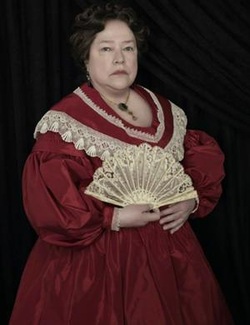
Every time I watch, I'm always wondering how the real life counterparts would stack up against their fictional twins. In some ways, the real people are more powerful and far more mysterious than anything Hollywood could create or dig up.

So, how does this stack up against reality?
Well, the real Marie Laveau was born in 1794 and died in 1881. She and her daughter (same name) practiced voodoo throughout New Orleans and over 12,000 people came to Lake Pontchartrain to see her perform her legendary rites on St. John's Eve.
When she died in 1881, it is believed that she was buried the Glapion family crypt, in Saint Louis Cemetery No. 1 in New Orleans. Tourists often visit the grave and draw an X on the tomb, believing that to do so will encourage Marie Laveau to grant your wish.
I based the character, Madame Desmarais from my Spiritus Series novels, on her and the belief that she could raise the dead on St. John's Eve. Of all the research I did for those novels, learning about her was the most interesting. I really hope to go to New Orleans one day and visit The Voodoo Museum and learn even more.

On the show, Delphine was a wealthy socialite known throughout New Orleans, but she was also a serial killer that tortured and murdered her slaves. Marie Laveau seeks revenge after the torture of her beau and curses Delphine with eternal life and trapped her in her grave.
Now that is some gruesome stuff that could never be reality...right? Wrong! The real Delphine LaLaurie was every bit as evil as her fictional character.
Madame LaLaurie did in fact keep slaves and was rumored to be quite cruel. A young slave girl fell to her death from an upstairs window while trying to escape a whip wielding LaLaurie. The death caused nnine slaves to be removed from the house. Now can you imagine how badly a person would have to treat a slave for Southern law to say that it was too much?
The slaves were bought back by relatives and returned to Madame LaLaurie and for a while, things went back to "normal" in the LaLaurie home, but it wouldn't be long before the entire world learned how crazy that "normal" was.

As reported in the New Orleans Bee of April 11, 1834, bystanders responding to the fire attempted to enter the slave quarters to ensure that everyone had been evacuated. Upon being refused the keys by the LaLauries, the bystanders broke down the doors to the slave quarters and found "seven slaves, more or less horribly mutilated ... suspended by the neck, with their limbs apparently stretched and torn from one extremity to the other", who claimed to have been imprisoned there for some months.
One of those who entered the premises was Judge Jean-Francois Canonge, who subsequently deposed to having found in the LaLaurie mansion, among others, a "negress ... wearing an iron collar" and "an old negro woman who had received a very deep wound on her head [who was] too weak to be able to walk." Canonge claimed that when he questioned Madame LaLaurie's husband about the slaves, he was told in an insolent manner that "some people had better stay at home rather than come to others' houses to dictate laws and meddle with other people's business."
When the discovery of the tortured slaves became widely known, a mob of local citizens attacked the LaLaurie residence and "demolished and destroyed everything upon which they could lay their hands". A sheriff and his officers were called upon to disperse the crowd, but by the time the mob left, the Royal Street property had sustained major damage, with "scarcely any thing [remaining] but the walls." The tortured slaves were taken to a local jail, where they were available for public viewing. The New Orleans Bee reported that by April 12 up to 4,000 people had attended to view the tortured slaves "to convince themselves of their sufferings."
The Pittsfield Sun, citing the New Orleans Advertiser and writing several weeks after the evacuation of LaLaurie's slave quarters, claimed that two of the slaves found in the LaLaurie mansion had died since their rescue, and added: "We understand ... that in digging the yard, bodies have been disinterred, and the condemned well [in the grounds of the mansion] having been uncovered, others, particularly that of a child, were found." These claims were repeated by Martineau in her 1838 book Retrospect of Western Travel, where she placed the number of unearthed bodies at two, including the child.
LaLaurie's life after the 1834 fire is not well documented. LaLaurie fled New Orleans during the mob violence that followed the fire, taking a coach to the waterfront and travelling by boat from there to Alabama and then on to Paris.
The circumstances of Delphine LaLaurie's death are also unclear. George Washington Cable recounted in 1888 a then-popular but unsubstantiated story that LaLaurie had died in France in a boar-hunting accident. Whatever the truth, in the late 1930s, Eugene Backes, who served as sexton to St. Louis Cemetery #1 until 1924, discovered an old cracked, copper plate in Alley 4 of the cemetery. The inscription on the plate read: "Madame LaLaurie, née Marie Delphine Macarty, décédée à Paris, le 7 Décembre, 1842, à l'âge de 6--."
According to the French archives of Paris, she did not die in 1842, but on December 7, 1849.

 RSS Feed
RSS Feed
